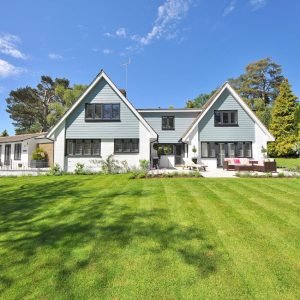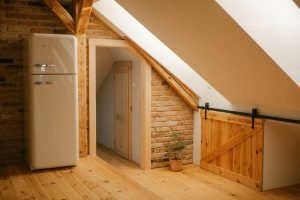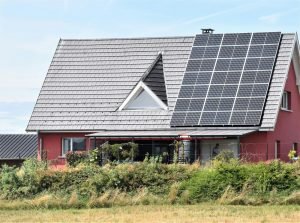Last Updated on October 8, 2024 by teamobn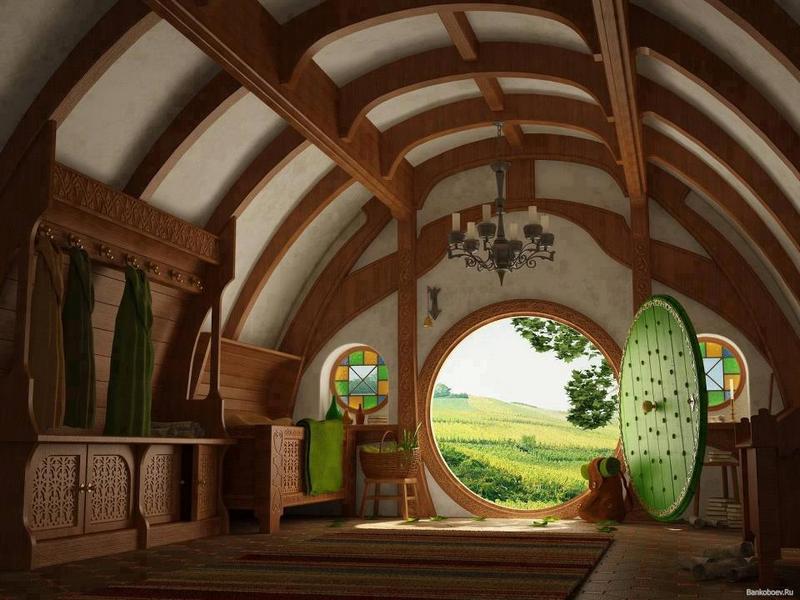
The Lord of the Rings movie trilogy may have made Hobbit Homes famous recently, but this building style has been around for centuries. Hobbit homes are a type of earth shelter dwellings built into hillsides.
They are usually round or oval, with a low door and windows set into the hill. In many ways, they resemble the ancient cliff dwellings of the Anasazi people of the American Southwest.
Hobbit homes, or smials, are built into the hillsides with round doors and windows. The interiors are cozy and comfortable, with plenty of nooks and crannies for storage. The homes are usually dug out of the hillside, with the excavated dirt used to create a mound in front of the door for extra insulation.
Hobbit homes offer a number of advantages as homes
Less maintenance
Hobbit homes stand out for their low maintenance requirements. The choice of natural materials like stone and wood blends these homes into their surroundings and minimizes the need for frequent repairs and updates. Unlike man-made materials, these natural options age well and require less care to maintain their appearance and function.
The construction of hobbit homes within hillsides or against natural land formations offers enhanced structural support. This integration with the landscape protects the homes from environmental stress, reducing the likelihood of damage from elements like wind or erosion. It also contributes to the structure’s overall stability, lessening the need for structural repairs.
The compact size of hobbit homes further reduces maintenance efforts. With smaller living spaces, there’s less interior and exterior surface area to manage. This means fewer tasks for homeowners, from cleaning to maintenance and repairs, making hobbit homes appealing for those seeking a simpler, more sustainable lifestyle.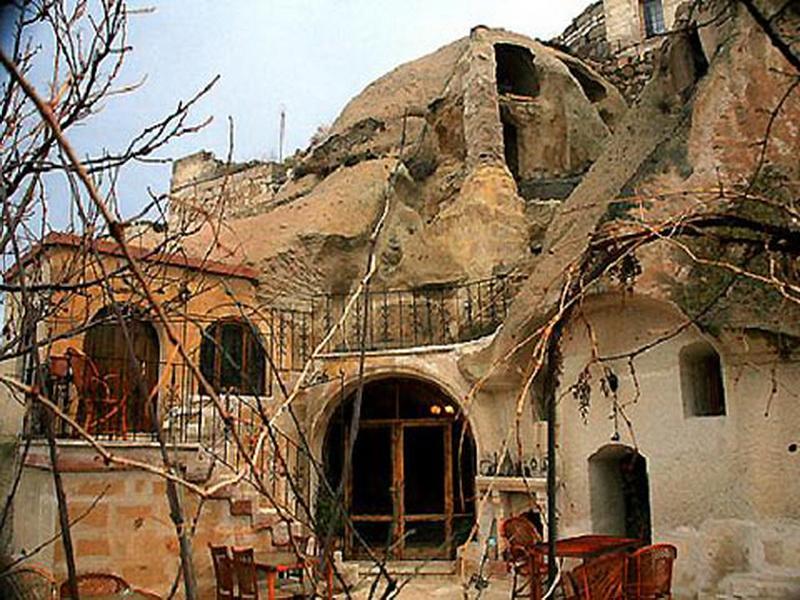
More privacy
Hobbit homes, inspired by the iconic dwellings featured in J.R.R. Tolkien’s Middle-earth universe, present a unique living environment that emphasizes privacy and intimacy far beyond what is typically found in conventional housing. These structures are ingeniously integrated into the landscape, such as hillsides, and are designed to blend seamlessly with their natural surroundings. This integration not only minimizes their visual impact but also enhances the sense of seclusion, making them an ideal choice for those seeking a retreat from the hustle and bustle of modern life.
The architectural design of Hobbit homes further contributes to their private and serene ambiance. With their characteristic earth-covered roofs, round doors, and windows, these homes are not just a nod to fantasy but are also practical in reducing noise pollution and ensuring a tranquil living space.
The small, cozy size of Hobbit homes fosters an atmosphere of warmth and closeness, encouraging more intimate social interactions and a stronger sense of community among inhabitants. Unlike traditional homes, which often feature large, open spaces that can feel impersonal, Hobbit homes are designed to be snug and inviting, with every nook and cranny serving a purpose.
Moreover, the placement of Hobbit homes within or against natural features not only aids in privacy but also provides an inherent connection to the environment. Residents of these homes often report a deep sense of harmony with nature, further contributing to their overall well-being and satisfaction.
The unique construction materials and methods used in building Hobbit homes, such as natural stone, wood, and earth, also play a critical role in creating a sustainable and environmentally friendly dwelling that appeals to those prioritizing a green lifestyle.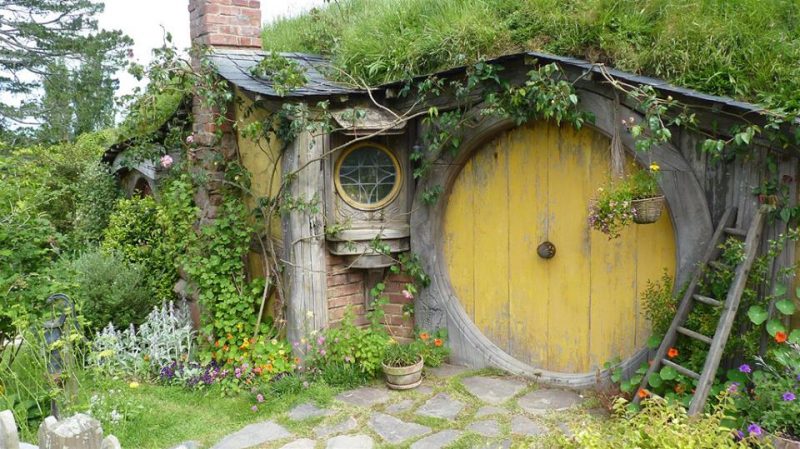
Excellent insulation characteristics
Hobbit homes, with their distinctive design inspired by the harmonious dwellings of fantasy literature, offer remarkable thermal insulation characteristics that stand out in sustainable and eco-friendly housing. The key to their exceptional thermal performance is their construction, specifically using earth-sheltered walls integral to their design. These earth walls provide a natural insulation layer that is highly effective in maintaining a stable interior temperature, regardless of the external weather conditions.
During the summer, when traditional homes might rely heavily on air conditioning systems to combat heat, Hobbit homes remain pleasantly cool. The thick earth walls absorb and dissipate the heat, preventing it from penetrating the home’s interior. This natural cooling effect is comfortable and significantly reduces the reliance on electrical cooling systems, leading to lower energy consumption and cost savings for the homeowner.
Conversely, in the winter, these same earth walls serve to retain heat within the home. The earth’s thermal mass acts as a natural insulator, trapping warmth inside and keeping the cold at bay. This inherent ability to maintain warmth reduces the need for artificial heating sources, further enhancing the energy efficiency of Hobbit homes and contributing to a lower carbon footprint.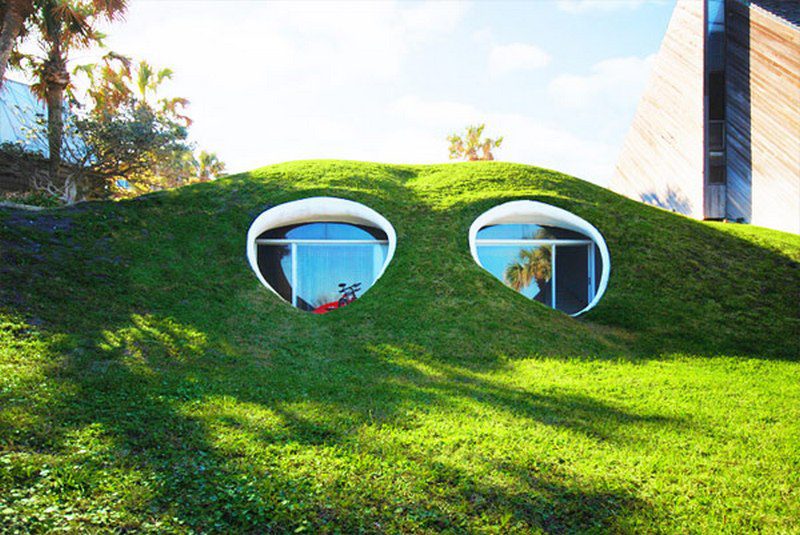
Very little fire risk
Hobbit homes, characterized by their unique integration into the natural landscape, inherently possess several fire safety features that significantly reduce the fire risk compared to conventional above-ground homes. These features make Hobbit homes safer in regions prone to wildfires or for homeowners concerned about fire safety.
One of the primary advantages of Hobbit homes regarding fire resistance is their construction within or against the earth. The soil and vegetation that cover these homes act as natural barriers against fire, providing an additional layer of insulation that can prevent or slow the spread of flames.
Unlike traditional construction materials such as wood or vinyl siding, which can be highly flammable and contribute to the rapid spread of fire, the earth and turf used in constructing Hobbit homes are naturally fire-resistant. This resistance is due to the soil’s capacity to absorb heat and act as a buffer between the home and any external flames, significantly reducing the likelihood of the home igniting.
Moreover, the compact size and design of Hobbit homes offer practical advantages in a fire emergency. Smaller living spaces allow quicker and more efficient evacuation, minimizing the time occupants can exit the home safely. This aspect is particularly advantageous in emergencies where every second counts. Additionally, the smaller footprint of Hobbit homes means fewer materials can catch fire, further diminishing the risk of a fire starting or spreading within the home.
The strategic placement of Hobbit homes, often built into hillsides or surrounded by natural terrain, also contributes to their fire safety. In contrast to homes that stand alone on open land, Hobbit homes benefit from the natural firebreaks provided by the landscape, such as rock formations or damp soil, which can halt the advance of wildfires and provide a natural defense against the spread of flames.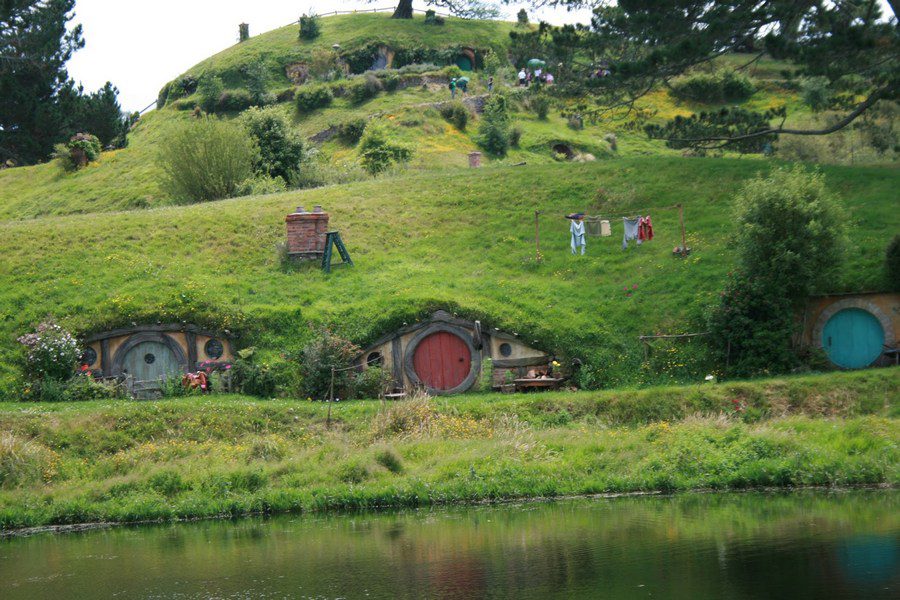
Saves more energy
Inspired by the eco-conscious designs of fictional earth-sheltered dwellings, Hobbit homes represent a pinnacle of sustainable architecture in the real world, achieving remarkable energy savings up to 50% compared to conventional homes. This substantial reduction in energy usage stems from their unique design elements, construction techniques, and the strategic use of natural materials, all of which contribute to their exceptional energy efficiency.
The construction of Hobbit homes involves using natural, locally sourced materials that inherently possess excellent insulation properties. Earth, the primary material used for the walls and roof of these homes, has a high thermal mass, meaning it can absorb and store heat energy.
This capacity allows the home’s interior to remain at a stable temperature, reducing the need for artificial heating and cooling. The insulation is further enhanced by using additional natural materials, such as stone and wood, often sourced from the surrounding environment, minimizing the ecological footprint of the construction process.
Another key feature contributing to the energy efficiency of Hobbit homes is their distinctive round shape and partially underground construction. This design integrates the home into its natural setting and minimizes exposure to the elements.
The earth covering provides natural insulation and protection against extreme weather, while the rounded shape of the home allows for wind deflection. This aerodynamic quality reduces wind pressure on the structure and minimizes heat loss, ensuring that the home retains warmth during colder months and remains cool during warmer periods without relying heavily on heating and cooling systems.
Moreover, the orientation and design of windows in Hobbit homes are carefully considered to maximize natural light and ventilation, reducing the need for artificial lighting and air conditioning. This thoughtful design approach saves energy and enhances the living environment, making these homes brighter, fresher, and more pleasant to inhabit.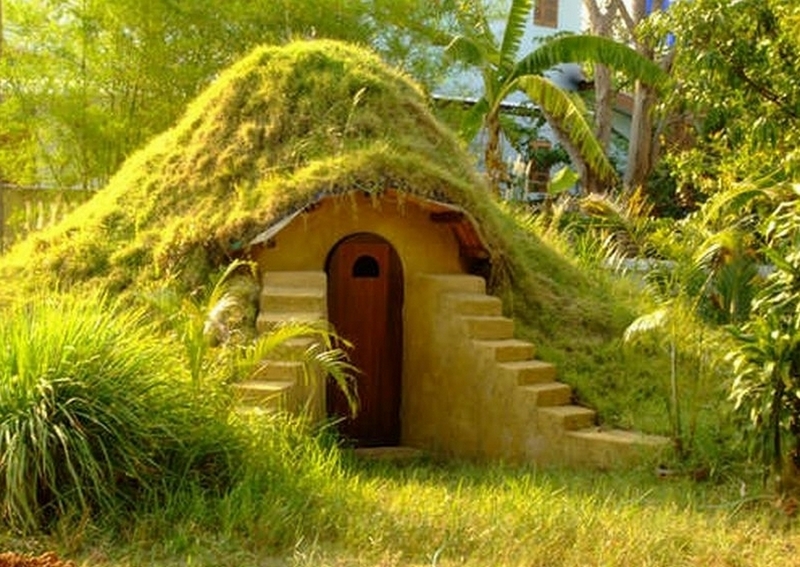
Actual Hobbit Homes
Earth House Estate, Switzerland
The Earth House Estate in Dietikon, Switzerland, stands as a prime example of hobbit home architecture in the real world. This estate marries the concept of sustainable living with the aesthetic appeal of hobbit homes. It utilizes earth-sheltered construction to provide excellent insulation, and the use of natural materials minimizes its environmental footprint. The design ensures each home is a part of the landscape, offering a peaceful and eco-friendly living space.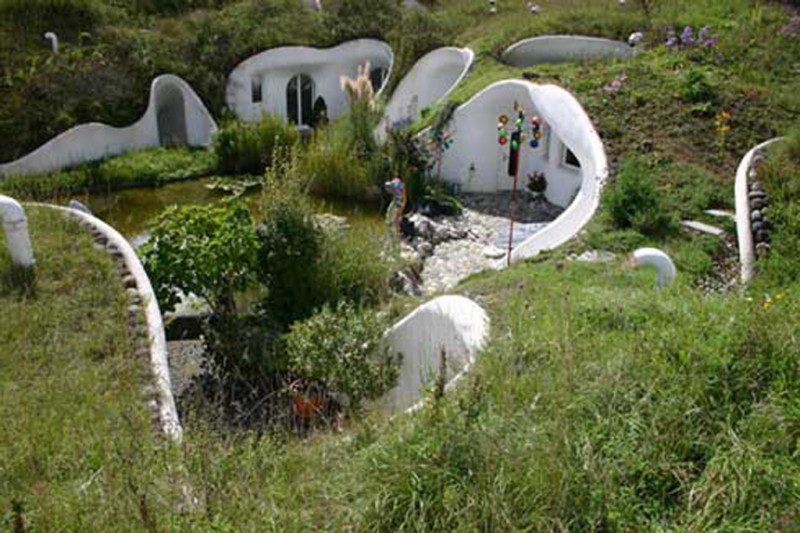
Hobbiton Movie Set, New Zealand
The Hobbiton Movie Set in Matamata, New Zealand, brings the fantastical hobbit homes of J.R.R. Tolkien’s universe to life. Originally constructed for the “The Lord of the Rings” film series, this site has become a tangible example of hobbit architecture. The set features the hallmark round doors and grass-covered roofs, creating an immersive experience highlighting the charm of living in harmony with nature.
Hobbit House, Montana, USA
In the United States, the Hobbit House in Montana is a private residence that captures the essence of hobbit-style living. Designed by architect Steve Michaels, this home showcases custom craftsmanship, from its unique round doors to the living roof that blends with the natural surroundings. The interior continues the theme, offering a cozy, intimate living space that prioritizes a close connection with the environment.
Click on any image to start the lightbox display. Use your Esc key to close the lightbox. You can also view the images as a slideshow if you prefer 😎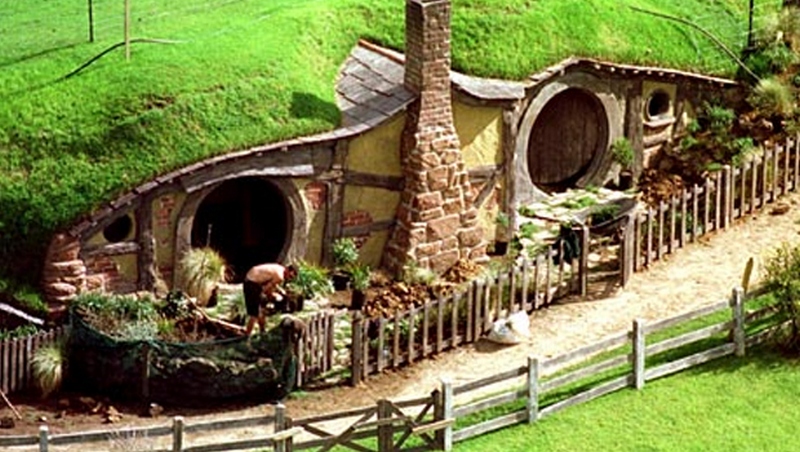




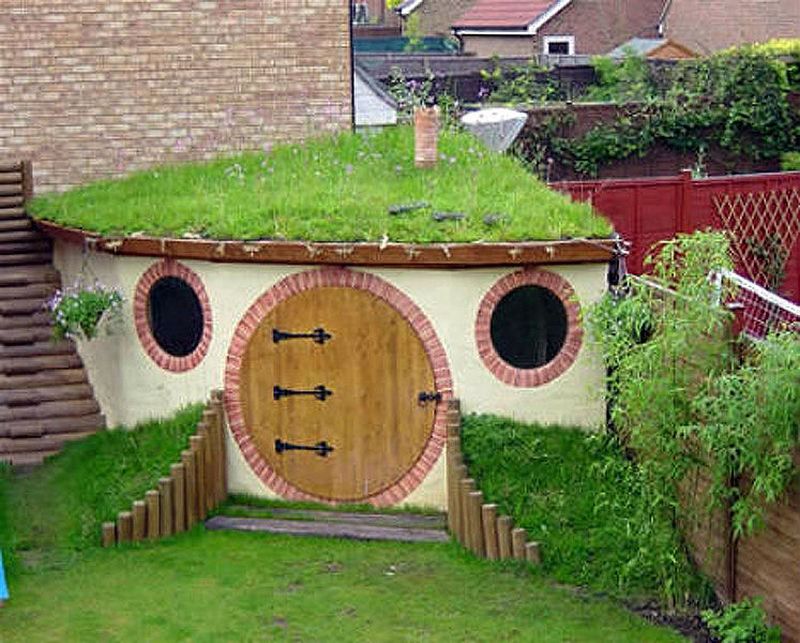

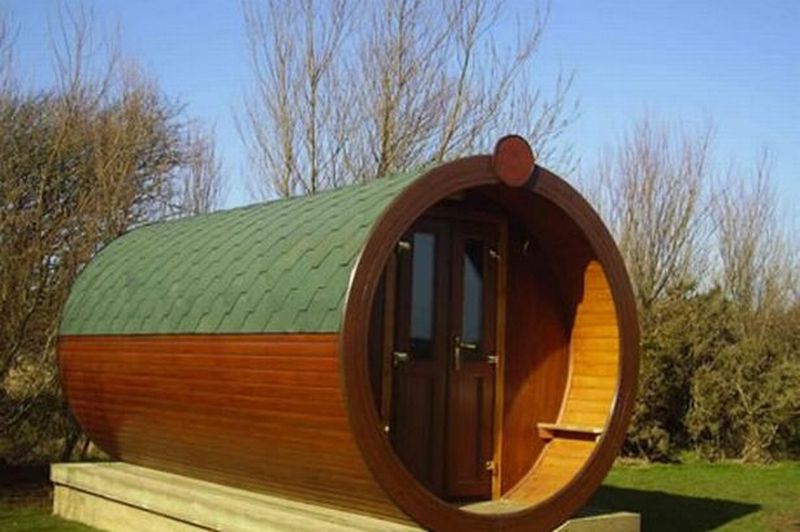
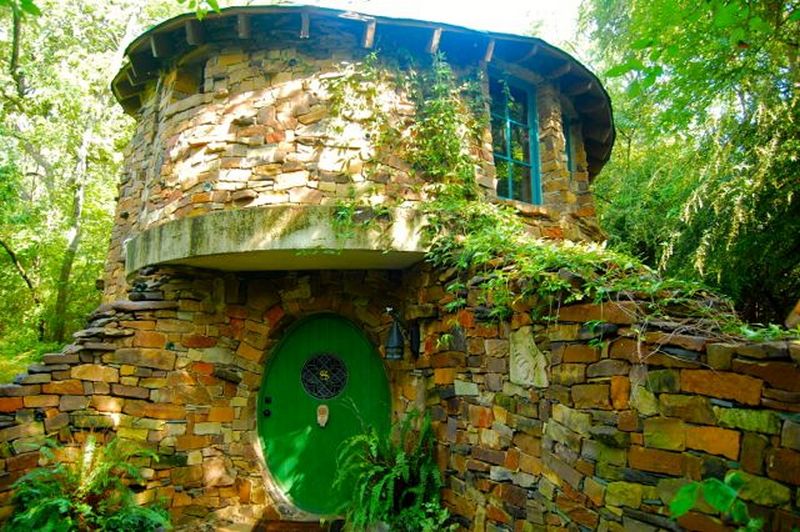



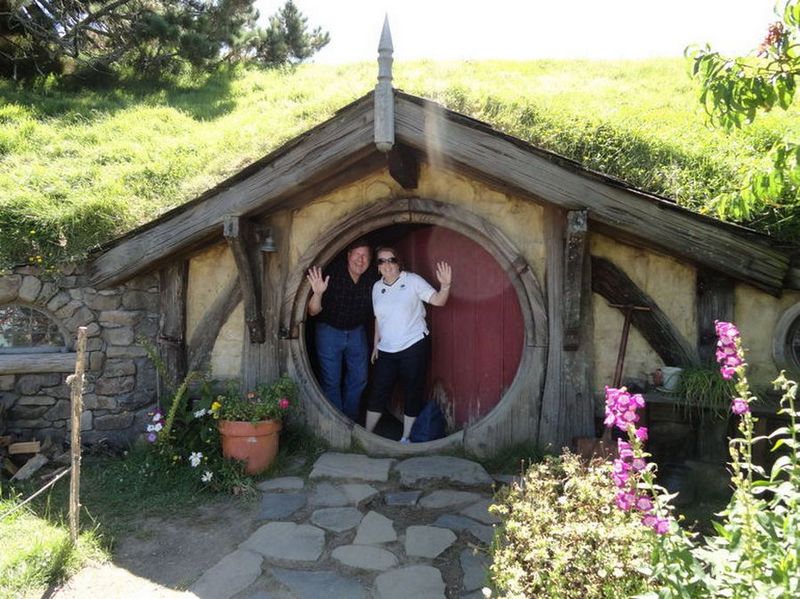

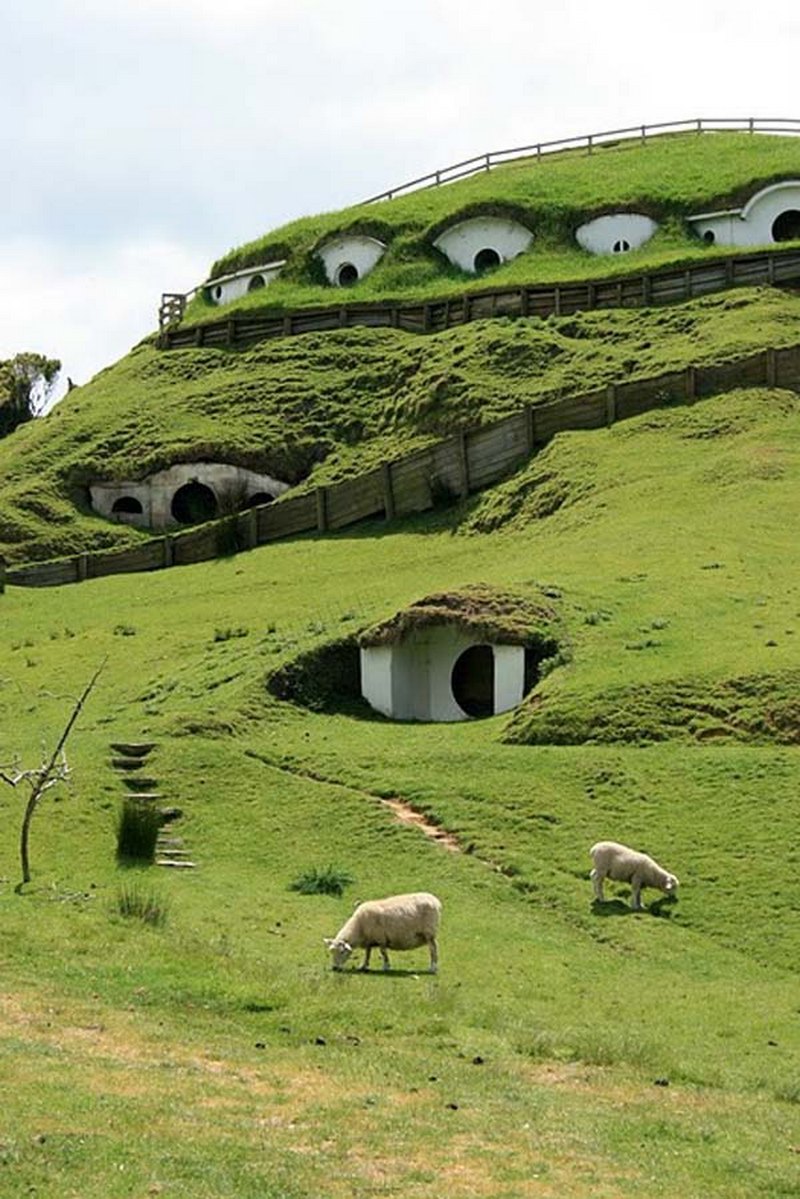
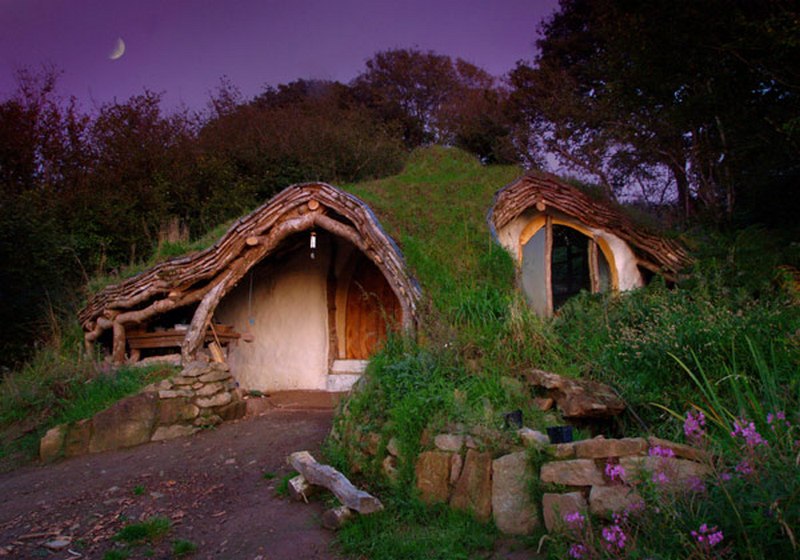
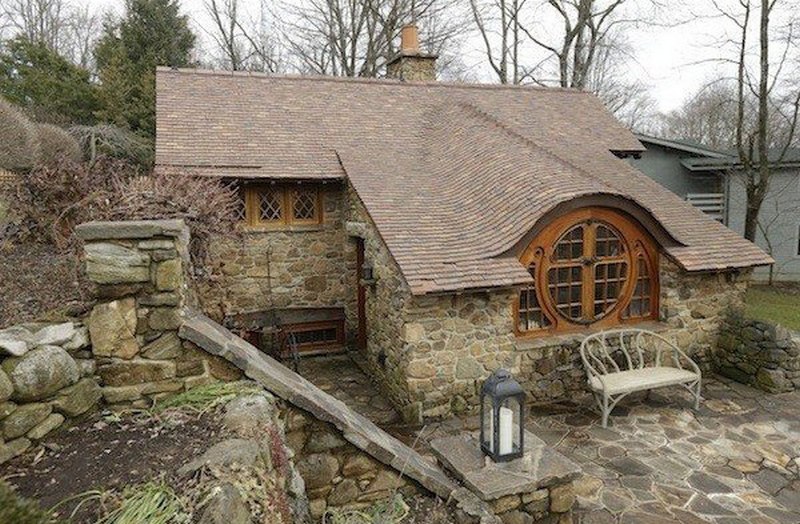
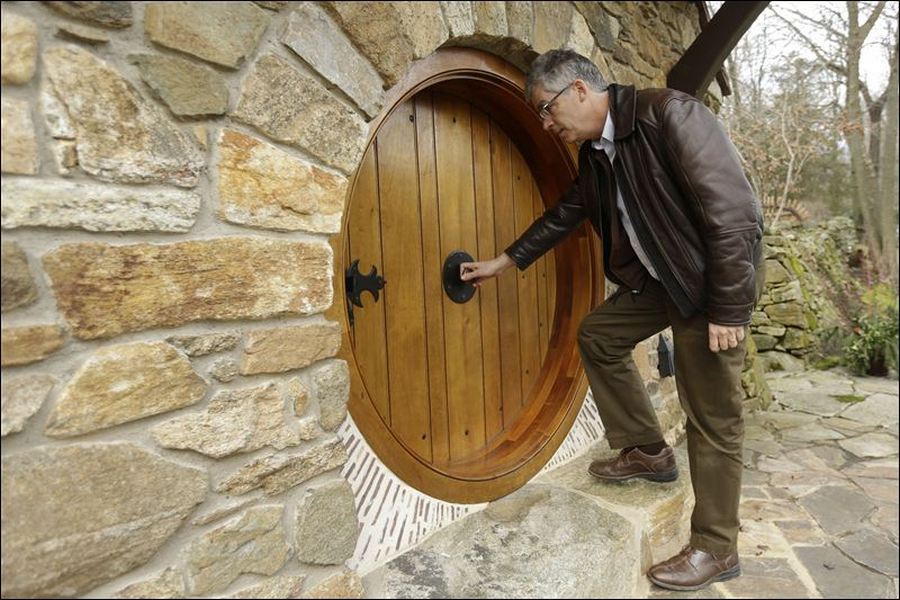

Cultural and Historical Influences
Hobbit homes’ distinctive design and connection to the earth draw inspiration from various cultural and historical sources. These structures are not just a product of modern fantasy but are deeply rooted in ancient building traditions and storytelling.
Ancient Building Traditions
Long before J.R.R. Tolkien penned his famous novels, people were constructing earth-sheltered dwellings. From the underground homes of the ancient Puebloans in North America to the turf houses in Iceland, these structures were designed to provide insulation against harsh climates and blend in with the natural environment. Hobbit homes mirror these ancient practices, emphasizing sustainability and a low-impact lifestyle.
Tolkien’s Middle-earth
The concept of hobbit homes was popularized by J.R.R. Tolkien’s “The Hobbit” and “The Lord of the Rings.” Tolkien’s detailed descriptions of the Shire and its cozy, earth-integrated homes captured the imagination of readers worldwide.
These fictional homes are a blend of English countryside charm and the practical aspects of ancient dwellings, reflecting Tolkien’s love for nature and traditional English landscapes.
Global Revival and Interest
The global success of “The Lord of the Rings” and “The Hobbit” movies brought a renewed interest in Hobbit-style architecture. This fascination has led to the creating hobbit homes as tourist attractions, private residences, and eco-friendly projects worldwide. The cultural impact of Tolkien’s work has spurred a movement towards more sustainable living practices, with hobbit homes serving as a symbol of living in harmony with nature.
The cultural and historical influences behind Hobbit Homes highlight the intersection of ancient building practices, literary inspiration, and modern sustainability trends. These homes remind us of the value of simplicity, the importance of preserving the environment, and the timeless appeal of storytelling in shaping our living spaces.
Modern Hobbit Homes and Commercial Projects
In recent years, the fascination with hobbit homes has moved beyond the pages of novels and screens of cinemas into real-world applications. Architects, builders, and enthusiasts have brought the concept to life, creating spaces that merge whimsical design with modern living.
Residential Projects
Worldwide, the hobbit home concept has captured the imagination of homeowners seeking a unique living experience. These residences are not just homes but personal sanctuaries that reflect a deep appreciation for nature and sustainable living.
Sustainable Materials and Construction
Modern hobbit homes prioritize using eco-friendly materials such as natural stone, wood, and recycled elements. Builders focus on minimizing environmental impact, selecting locally sourced materials to reduce carbon footprints. The construction process emphasizes harmony with the surrounding landscape, often incorporating existing land features to preserve natural beauty and biodiversity.
Green Roofs and Energy Efficiency
A defining feature of many residential hobbit homes is the green roof. These living roofs provide excellent insulation, reduce rainwater runoff, and help the structures blend into their natural settings. Inside, energy-efficient designs are standard, with features like solar panels, geothermal heating, and natural cooling systems. These technologies work together to significantly reduce energy consumption, lower utility costs, and promote a sustainable lifestyle.
Customized to Modern Lifestyles
While inspired by the quaint homes of the Shire, these modern hobbit homes are fully equipped to meet the demands of contemporary life. Designers skillfully integrate modern amenities and technologies, ensuring each home is comfortable and functional. From spacious kitchens to luxurious bathrooms, every aspect is thoughtfully planned to enhance the living experience without compromising the aesthetic appeal.
Homeowners of these unique dwellings enjoy the best of both worlds: the enchantment of a fantasy-inspired home and the conveniences of modern living. These residences testify to the creativity and innovation possible when traditional architecture meets contemporary green building practices.
Commercial Ventures
The allure of hobbit homes has transcended private residences, significantly impacting the hospitality industry. Hotels, resorts, and vacation rentals fashioned after these iconic dwellings provide guests with an unforgettable escape into fantasy and tranquility.
Eco-friendly Design and Construction
In constructing these commercial hobbit homes, developers prioritize sustainability. They often use materials sourced from the local environment, such as earth, stone, and wood, to minimize their ecological footprint.
The design of these structures typically includes features like green roofs, natural insulation, and energy-efficient systems that ensure a comfortable stay while respecting the planet. This commitment to eco-friendly practices appeals to environmentally conscious travelers and enhances the natural beauty of the accommodations.
Unique Guest Experiences
Hobbit-inspired commercial properties offer more than just a place to stay; they provide a comprehensive experience. Guests can immerse themselves in environments that feel as if they’ve stepped straight out of the pages of Tolkien’s novels.
Every detail is designed to transport visitors to the Shire, from the round doors and cozy interiors to the lush, green surroundings. These ventures often include themed activities, such as guided tours of the property, storytelling sessions, and traditional Hobbit meals, to deepen the immersive experience.
Modern Amenities in a Fantasy Setting
Despite their rustic charm, hobbit-inspired commercial properties have the amenities and comforts modern travelers expect. Wi-Fi, hot showers, luxurious beds, and gourmet dining options are seamlessly integrated into the setting, ensuring guests enjoy both the whimsy of a hobbit hole and the conveniences of contemporary accommodation.
This blend of fantasy and functionality makes these ventures appealing to a broad audience, from die-hard Tolkien fans to travelers simply looking for an extraordinary getaway.
These commercial ventures have successfully tapped into the growing desire for travel experiences that are not only unique and immersive but also sustainable and respectful of the environment. They stand as a testament to the enduring appeal of Tolkien’s world and the innovative ways in which the hospitality industry can bring fantasy to life.
Eco-friendly Initiatives
Hobbit home projects are not just a nod to fantasy; they are at the cutting edge of sustainable living and architectural innovation. These initiatives are redefining what it means to live in harmony with the environment, offering lessons in green living that are applicable worldwide.
Integration with Nature
One of the hallmarks of hobbit home design is its seamless integration into the natural landscape. Architects and builders take great care to ensure that these structures disturb the land as little as possible.
By building into hillsides or utilizing natural depressions, hobbit homes maintain the integrity of the site, preserving native vegetation and wildlife habitats. This approach minimizes environmental impact and enhances the living space’s beauty and tranquility, making it a part of the ecosystem rather than an imposition on it.
Sustainable Materials and Practices
The use of natural, locally sourced materials is central to the construction of hobbit homes. Wood, stone, and earth are preferred for their low environmental impact, durability, and thermal properties. These materials are often recycled or harvested sustainably, reducing waste and promoting a circular economy.
Additionally, the construction process emphasizes minimal disturbance to the site, using eco-friendly and efficient techniques. This commitment to sustainable materials and practices extends to the interior of hobbit homes, where furnishings and finishes are chosen for their eco-friendly credentials.
Cost-Effective Factor of Hobbit Homes
Energy efficiency is another cornerstone of hobbit home design. These homes are built with insulation and passive solar principles in mind, making the most of natural light and the earth’s insulating properties to maintain comfortable temperatures year-round.
Many hobbit homes incorporate renewable energy sources, such as solar panels or geothermal heating systems, to reduce reliance on fossil fuels. Rainwater harvesting and on-site wastewater treatment are also common features, contributing to the self-sufficiency of these homes and minimizing their impact on local water resources.
The trend towards modern hobbit homes and commercial projects reflects a growing desire for living spaces that are both imaginative and sustainable. These developments prove that the appeal of hobbit homes extends beyond their literary origins, offering practical solutions for eco-friendly living and unique experiences in the hospitality industry.
Conclusion
The concept of hobbit homes extends far beyond their literary origins, embodying principles of sustainability, integration with nature, and energy efficiency that broadly affect contemporary living. From private residences inspired by the charm of the Shire to commercial ventures that transport guests to a fantasy world, hobbit homes demonstrate the versatility and appeal of eco-friendly architecture.
If you liked these, you will also like viewing these other homes…
FAQ: Hobbit House
How cost-effective are Hobbit Homes in terms of heating, cooling, maintenance, and repairs?
They are also naturally insulated and require minimal maintenance, further making them cost-effective as a compact home.
What are the materials used in the construction of a Hobbit home?
Constructing a hobbit house is possible with natural stone, wood, and recycled elements. These materials can be sourced from one’s surroundings or even from vendors selling reclaimed lumbers. The economical construction of a hobbit house makes them costs around $1.00 per sq. ft., thanks to the materials used.
How do Hobbit houses prevent mold and moisture?
Advanced ductwork within the structure allows for optimized airflow, keeping the interior dry and comfortable. A good dehumidifier can further enhance the airflow. It is important to note that its exterior walls are made from thick earth to prevent dampness from seeping inside.
How resistant are hobbit homes to pests and infestations?
The earthen walls of Hobbit houses remove any possible passages for pests to enter their exteriors. Their construction also removes any possible habitations for ants or other similar infestations.
How Easy and Quick is the Assembly of a Hobbit Home?
Building a Hobbit Home is surprisingly quick and straightforward. The assembly process typically takes three to four days, making it an efficient choice for those eager to move into their unique abode. The walls and interiors require just the basic tools.
What are the disadvantages of living in a Hobbit home?
The unique construction of a hobbit house will make it difficult to finance them. Banks are unfamiliar with this type of structure and may not find the right mortgage product. Lighting will also be a challenge with hobbit homes. Its earthen walls cannot spread the natural light within its exteriors.



